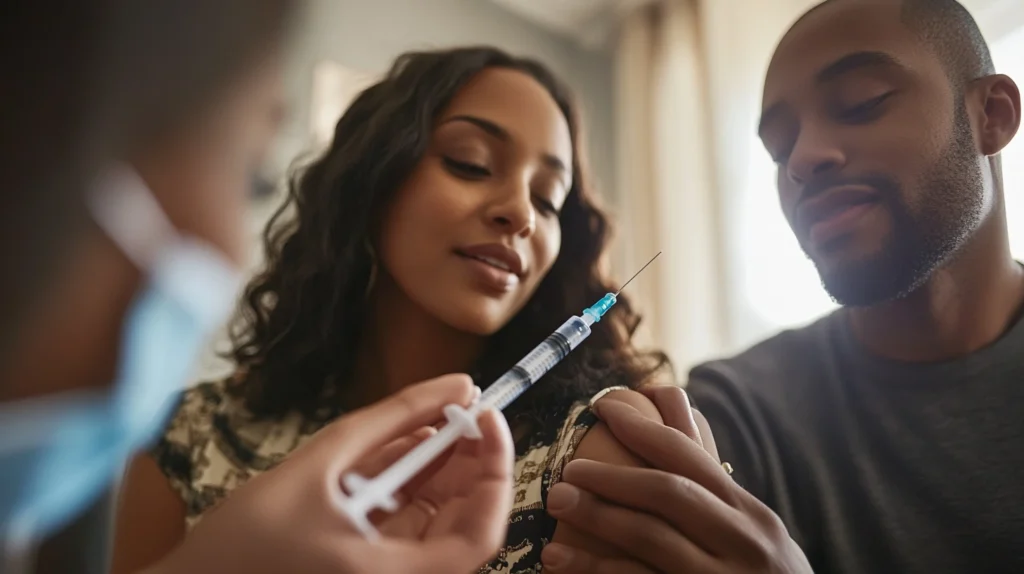For many lesbian couples, the dream of starting a family is both exciting and deeply meaningful. But one question often arises first: how do lesbian couples conceive?
Thanks to advances in reproductive technology and inclusive healthcare, there are now multiple ways for lesbian couples to have children — allowing both partners to be emotionally and, in some cases, biologically involved in the process.
In this guide, we’ll break down everything you need to know — from medical options like IUI, IVF, and reciprocal IVF to legal rights, emotional considerations, and the costs of each method. Whether you’re just starting your journey or exploring advanced fertility options, this article will help you understand exactly how lesbian couples conceive and what steps to take next.
Table of Contents
Understanding How Do Lesbian Couples Conceive
What Does Conception Mean for Lesbian Couples?
Because two women cannot biologically conceive together without sperm, lesbian conception always involves some form of medical assistance. The process can vary depending on:
- Which partner will carry the pregnancy
- Whose eggs will be used
- Whether the sperm donor is known or anonymous
Each couple’s journey is unique, but the goal is always the same — to build a loving family through a process that feels right for both partners.
Assisted Reproductive Technologies for Lesbian Couples
There are several fertility methods that make conception possible for same-sex female couples. The most common include intrauterine insemination (IUI), in vitro fertilization (IVF), and reciprocal IVF.
1. Intrauterine Insemination (IUI)
IUI is often the first step many lesbian couples take when trying to conceive. During this procedure, donor sperm is inserted directly into the uterus at the time of ovulation.
It’s a simple, low-cost, and relatively non-invasive method that works best for couples with no known fertility issues. Some couples may also take fertility medications to boost egg production and increase chances of success.
Pros:
- Affordable and minimally invasive
- Can be done at a clinic or, in some cases, at home under guidance
Cons:
- Lower success rate per cycle compared to IVF
- May require multiple cycles
Average cost: $300–$1,500 per cycle
2. In Vitro Fertilization (IVF)
IVF is a more advanced fertility treatment. It involves retrieving eggs from one partner (or a donor), fertilizing them with donor sperm in a lab, and then transferring the resulting embryo into the uterus.
This method offers higher success rates and more control over the process — for example, selecting embryos with the highest potential for pregnancy.
Pros:
- Higher success rate per attempt
- Can use either partner’s eggs
- Option for genetic testing of embryos
Cons:
- Expensive and more medically involved
- Requires hormone treatments and egg retrieval
Average cost: $12,000–$20,000 per cycle
3. Reciprocal IVF: Sharing the Journey

One of the most meaningful advancements for lesbian couples is reciprocal IVF, which allows both partners to share in the biological process.
Here’s how it works:
- Eggs are retrieved from Partner A.
- The eggs are fertilized in a lab with donor sperm.
- The resulting embryo is implanted into Partner B’s uterus.
This way, one partner provides the genetic material, and the other carries the pregnancy, creating a shared biological and emotional connection.
Pros:
- Both partners participate biologically
- Deep emotional bond through shared parenthood
Cons:
- More expensive than standard IVF
- Requires synchronization of both partners’ cycles
Average cost: $15,000–$25,000 per cycle
Choosing Donor Sperm: Known vs. Anonymous
A crucial part of lesbian conception is choosing the right sperm donor. You can select a known donor (such as a friend or relative) or an anonymous donor through a sperm bank.
Known donor:
- Offers personal connection and medical history transparency
- May create legal or emotional complexities
Anonymous donor:
- Ensures privacy and clear legal boundaries
- Comes with detailed genetic and health screening
Typical cost: $500–$1,000 per vial
Some couples purchase multiple vials from the same donor for future siblings to maintain genetic consistency.
Legal Considerations for Lesbian Parents
Do Lesbian Couples Need to Adopt Their Baby?
In many states, even if both mothers’ names appear on the birth certificate, the non-biological parent may still need to complete a second-parent adoption to secure full legal rights.
This ensures both partners are recognized as legal parents — protecting custody, inheritance, and medical decision-making rights.
Why Legal Counsel Matters
Because laws vary from state to state, consulting a family lawyer experienced in LGBTQ+ rights is essential. They can help navigate:
- Parental recognition
- Donor agreements
- Birth certificate registration
Legal fees typically range from $2,000–$5,000, depending on your location and situation.
The Costs of Conception for Lesbian Couples
Let’s compare the typical expenses associated with each fertility option:
| Method | Description | Estimated Cost (USD) |
|---|---|---|
| IUI | Simple insemination using donor sperm | $300–$1,500 per cycle |
| IVF | Lab fertilization and embryo transfer | $12,000–$20,000 per cycle |
| Reciprocal IVF | Shared process between partners | $15,000–$25,000 per cycle |
| Donor Sperm | Sperm bank or known donor | $500–$1,000 per vial |
| Legal Services | Adoption, contracts, rights | $2,000–$5,000 |
While these numbers can seem overwhelming, many clinics offer financing plans, and some insurance policies now include fertility coverage for same-sex couples.
Emotional and Relationship Considerations

Supporting Each Other Through the Journey
The road to parenthood can be deeply emotional — filled with excitement, hope, and sometimes stress. Open communication, empathy, and patience are essential.
Many couples find it helpful to:
- Attend counseling together
- Join LGBTQ+ parenting groups
- Celebrate small milestones along the way
Strengthening Your Relationship
Before starting, talk about expectations:
- Who will carry the baby (now or in the future)?
- How will parenting responsibilities be shared?
- What values do you both want to raise your child with?
Having these conversations early builds trust and emotional stability during the fertility journey.
Can Two Women Have a Biological Baby Together?
This is a question many people ask when exploring how lesbian couples conceive.
Currently, two women cannot have a biological baby using only their genetic material — sperm is still necessary for fertilization. However, scientists are researching future technologies, such as creating sperm cells from female DNA. These breakthroughs are still experimental and not yet available for human use.
So, while science continues to evolve, donor sperm remains essential for lesbian conception today.
Choosing the Right Fertility Clinic
When selecting a clinic, it’s important to find one that’s LGBTQ+-friendly and experienced in working with same-sex couples.
Look for clinics that:
- Offer inclusive language and supportive staff
- Have success stories with lesbian couples
- Provide transparent pricing and legal guidance
Reading reviews, joining online communities, and speaking to other lesbian parents can help you find the right fit.
Frequently Asked Questions (FAQs)
1. What are the main ways lesbian couples can conceive?
Lesbian couples typically choose IUI, IVF, or reciprocal IVF, all involving donor sperm.
2. How much does it cost for lesbian couples to conceive?
Costs range from around $300 for IUI to over $25,000 for reciprocal IVF and legal fees combined.
3. Can two women have a biological baby together?
Not yet. Research continues, but donor sperm is still required for fertilization.
4. What is reciprocal IVF?
A method where one partner provides eggs, and the other carries the pregnancy — allowing both to share the biological process.
5. Do lesbian couples have to adopt their own baby?
In some states, yes. A second-parent adoption ensures both partners are legally recognized as parents.
Conclusion: Building a Family Together
Learning how lesbian couples conceive opens the door to countless possibilities for love, connection, and family. Whether you choose IUI for its simplicity, IVF for its success rate, or reciprocal IVF for its shared experience, every path is valid and beautiful.
What matters most is that you approach the journey with knowledge, patience, and mutual support. With today’s reproductive technologies and growing legal protections, lesbian couples have more options than ever to create the families they’ve always dreamed of.
If you’re ready to take the next step, start by connecting with an LGBTQ+-friendly fertility clinic — and begin your journey toward motherhood, together. 🌈
